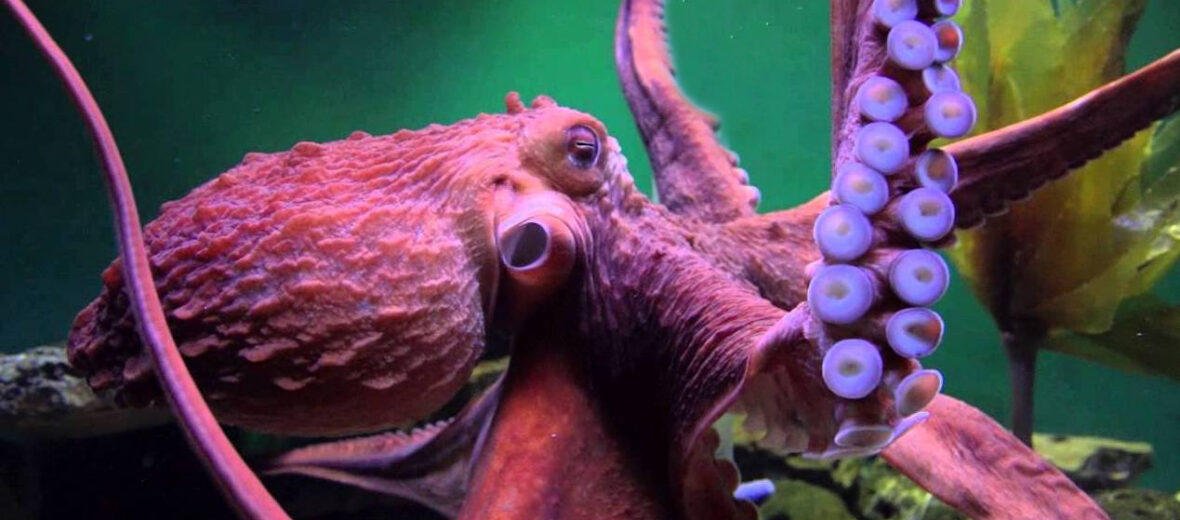
The giant Pacific octopus is touted as being the largest known octopus in the world. Impressive, as there are 300 known species of octopuses in the world’s oceans. These cephalopods are actually mollusks. Their shells are just located inside their head as 2 small plates and the remainder of their body is soft and malleable. A cephalopod’s closest relatives are snails, slugs, and clams.
First the Stats…
Scientific name: Enteroctopus dofleini
Weight: Up to 110 lbs.
Length: Up to 16 feet
Lifespan: Up to 5 years
Now on to the Facts!
1.) “What’s the difference between a squid and an octopus,” you may ask? The main difference is in the arms/tentacles. Octopuses have 8 arms, while squids, on the other hand, have 8 arms and 2 tentacles.
2.) Their primary prey items consist of clams, crabs, shrimp, fish, and they’ve also been documented going after birds!
3.) Octopuses are able to gain 1 – 2% of their body weight every day! That is equal to a human gaining 2 – 4 lbs. a day!
4.) Like squid, octopuses don’t have a skeletal system, but they do have a beak. This beak is razor sharp and used to crack open hard shells of clams and exoskeletons of crabs.
5.) Being highly intelligent, these creatures are renown escape artists. There have been documented cases of a Pacific octopus opening its enclosure, sliding across the floor to another enclosure, opening that enclosure, capturing the tasty treat inside, and then making its way back to it’s original enclosure. “Shhh. Don’t tell the aquarists that I stole their crabs.”
But wait, there’s more on the giant Pacific octopus!
6.) They can fit through any opening large enough to get their beak through. If the beak fits, so do they.
7.) The skin of all cephalopods is covered in tiny colored cells called chromatophores. Under those cells lies reflective iridocytes. They have the ability to control these cells to change to a myriad of colors. They can change colors in 1/10th of a second!
Did you know…?
Octopuses have 3 hearts and 9 brains! 2 hearts pump blood to their gills and the remaining heart pumps blood to the rest of the body. 1 brain controls their central nervous system and their arms each have their own smaller brain to control movement.
8.) Besides being able to change colors, they are also able to change the very texture of their skin.
9.) These giants have 2,140 – 2,240 suction cups on their 8 arms, giving them not only a very strong grip but also an amazing sense of taste and smell. That’s right, they use their arms to taste and smell, being as they have no nose.
10.) While being housed in public aquariums, their stewards will help keep the octopuses enriched by hiding food in closed jars and puzzles. They will also feed them live crustaceans.
But wait, there’s still more on the giant Pacific octopus!
11.) The female will lay up to 74,000 eggs! Most of those never make it to adulthood though.
12.) Females only live between 3 – 4 years. Being a devout mother, she will guard and fan her eggs till they hatch, fasting the whole time. The exhaustion of this, along with her self cannibalization, ultimately kills her.
13.) 1 trick that aquarists use to keep octopuses from escaping is to line the top of the aquarium with AstroTurf. The texture of this substance repels the escapee so they don’t try to get out.
14.) Seals, sharks, sea otters, and large fish all prey on these critters.
Now a Giant Pacific Octopus Video!
Also, check out the Critter Science YouTube channel. Videos added frequently!
Want to suggest a critter for me to write about? Let me know here.



